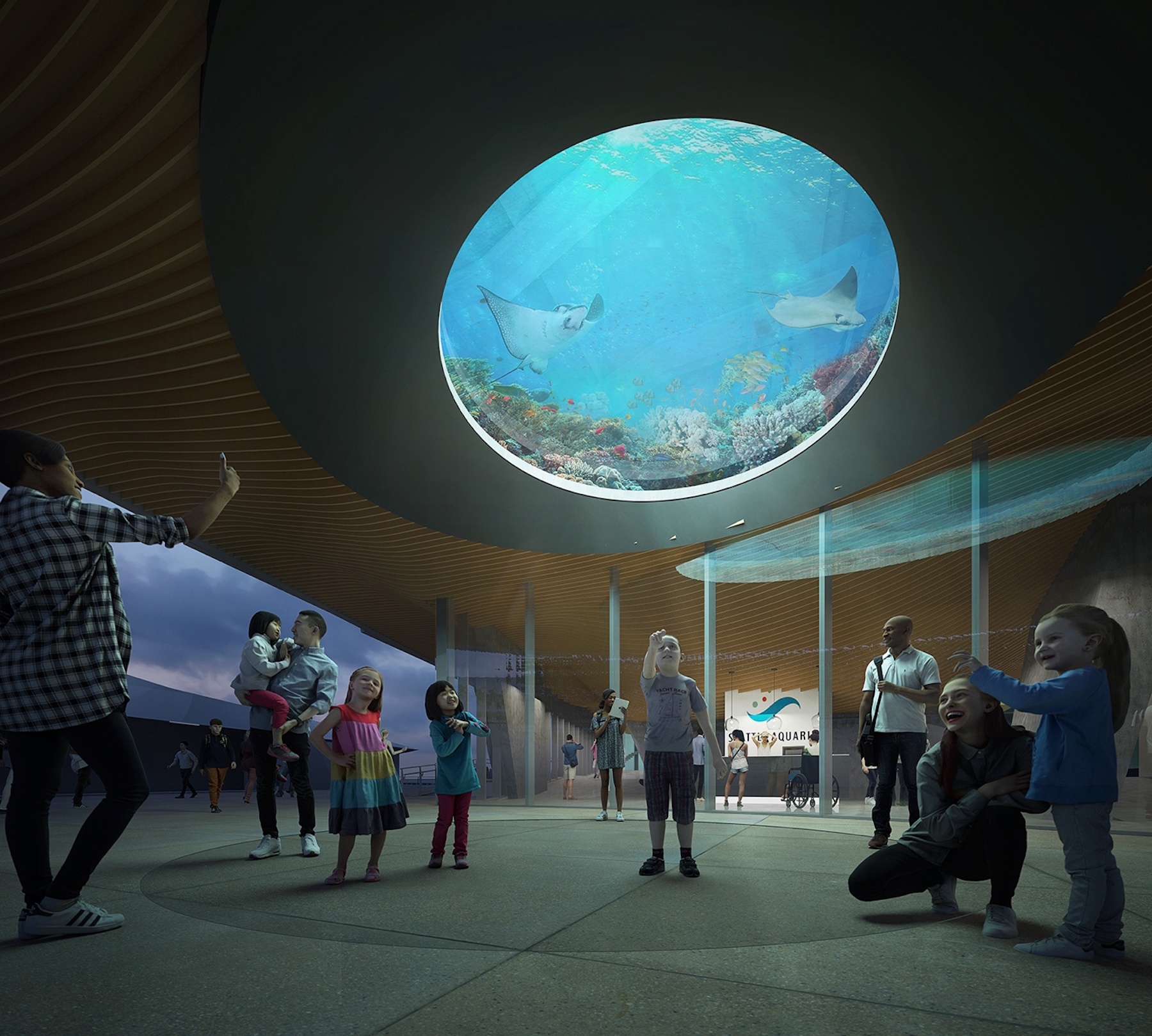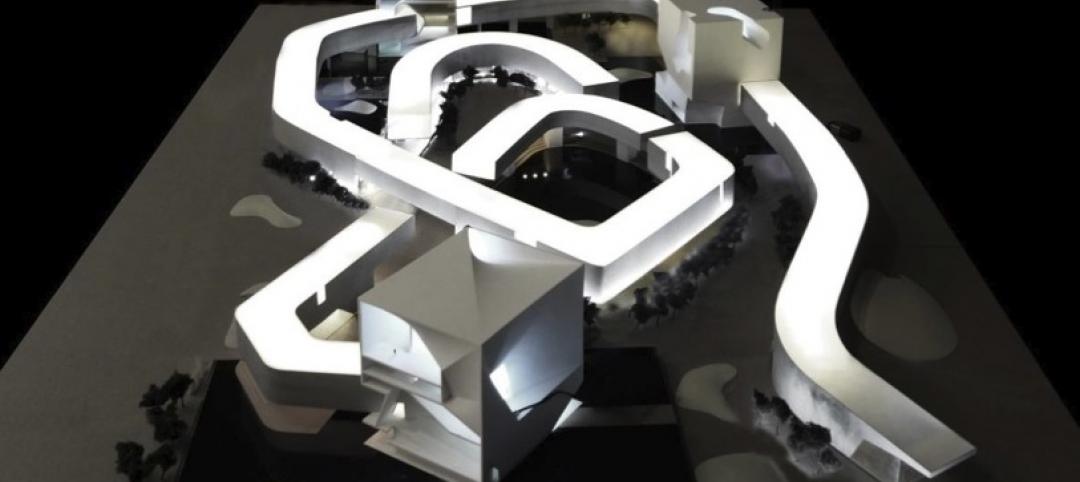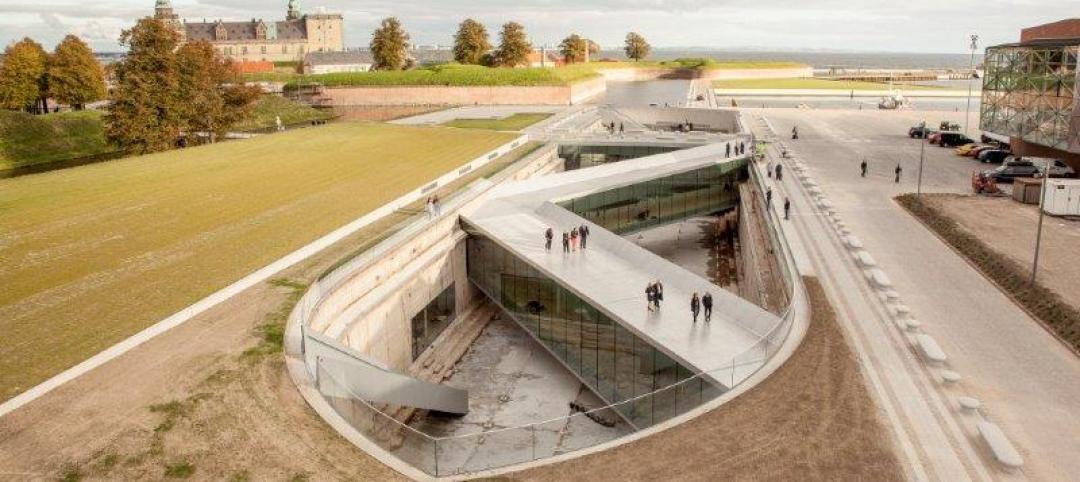Seattle Aquarium’s new Ocean Pavilion, currently under construction, features several exhibits that examine the human connection with the Earth’s oceans. The 49,000 sf Ocean Pavilion has 19 living exhibits organized around The Reef, a new 362,000 gallon, two-story living habitat that is visible from five unique perspectives.
The Reef depicts a biodiverse Coral Triangle reef community, featuring an expansive, nearly 30-foot-wide domed view on the ground floor and additional viewing windows on an upper gallery. Cantilevered over the Pavilion’s entrance, it also features the “oculus”—a 16-foot wide portal that allows passersby to stand beneath and view the exhibit without paying admission.
The aquarium’s new pavilion is “the spectacular northern focal point of the reimagined Seattle waterfront,” according to Thinc, the firm that designed the exhibitions. LMN Architects is the design architect on the project, and is collaborating with Thinc on the exhibitions. “Thinc views every possible part of the Aquarium as useful context for building relationships with the public. Even the parts normally hidden from view consciously reveal the tank habitat vessels and back of house, all designed both for functionality and beauty.”
“To imagine an aquarium built around ethical human relationships with the ocean means throwing out the playbook on how you design aquariums,” said Tom Hennes, founder and principal of Thinc. “We can touch people deeply and enrich their relationship with the natural world, and we can also be a vital instrument of social change that catalyzes public engagement toward a thriving future.”
The Pavilion exhibition is organized into eight areas: 1) the entry/exit; 2) One Ocean Hall; 3) At Home in the Ocean; 4) The Archipelago (lower level view); 5) Window on The Reef (a dramatic, 30-foot wide domed window); 6) The Archipelago (upper level); 7) The Reef (upper level with three distinct views); and 8) Behind the Scenes (includes Jelly Nursery and Programming Area).
Dramatic living exhibits, engaging storytelling, and immersive multimedia installations will envelop visitors in the webs that connect ocean life to the complex arenas of human activity. The design was focused on realizing the Aquarium’s vision to make ocean conservation a global imperative, a community value, and a deeply personal priority for all. The Ocean Pavilion provides new opportunities for the Aquarium’s community to learn about the connections between Seattle’s local waters and the world’s oceans.
A collaboration with Coast Salish Tribal and Urban Native community members, as well as Indo-Pacific conservation partners, informed Thinc’s treatment of narratives and the design of the Ocean Pavilion. The design process included focused workshops and listening sessions with Coast Salish elders and tribal youth, and Urban Native community members, who contributed to the outcome.
The Ocean Pavilion is scheduled to open in 2024.
On the Building Team:
Owner and/or developer: Seattle Aquarium Society
Exhibition Designer: Thinc Design
Design architect & Architect of Record: LMN Architects
MEP engineer: PAE
General contractor/construction manager: Turner Construction Company
Horticulture Consultant: Zoo Horticulture Consulting and Design
Lighting Consultant: Palazzo Lighting
Technology Consultant: Teecom
Focus Tank LSS: Tenji
Development Manager: Shiels Obletz Johnsen (SOJ)
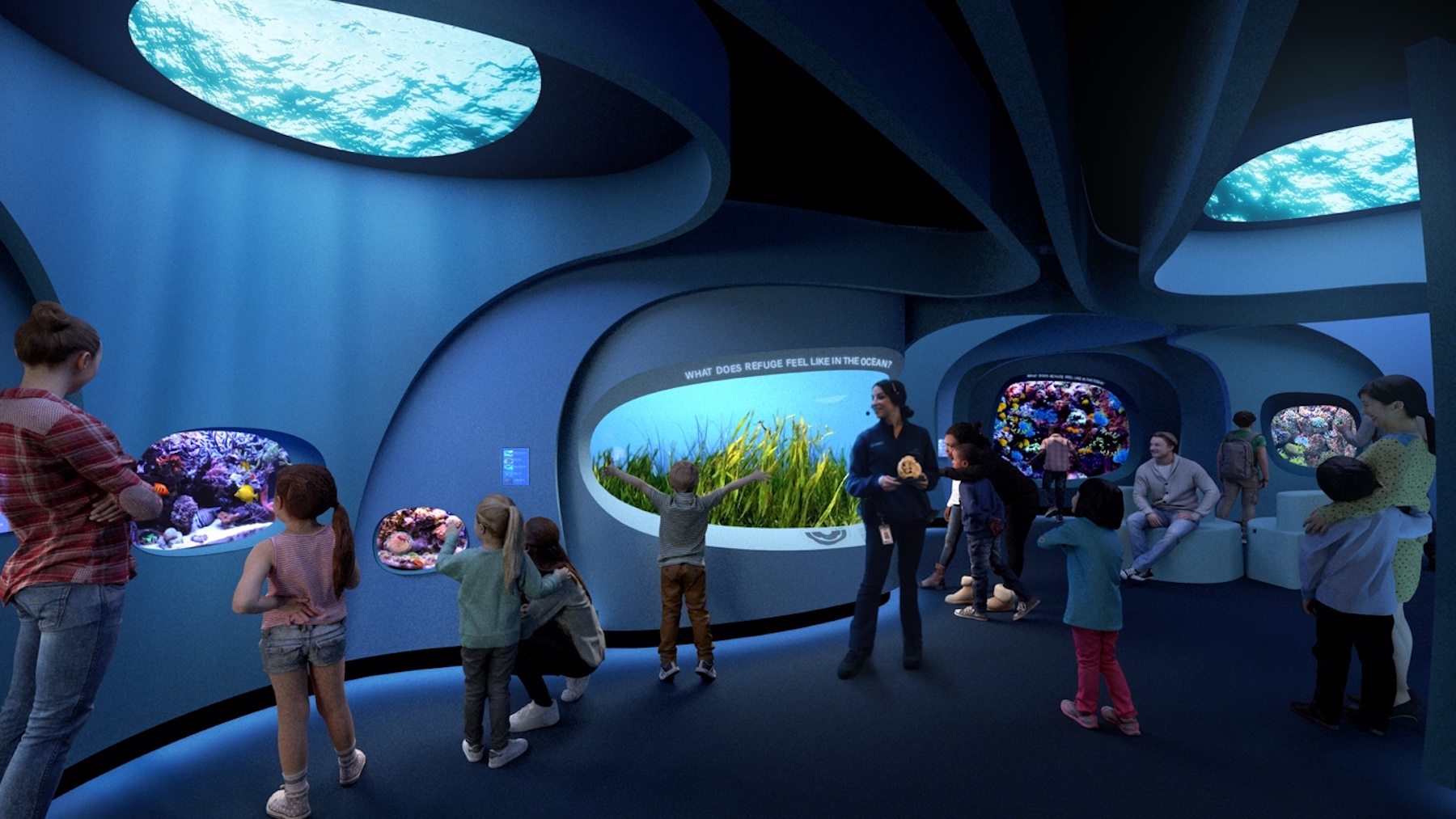
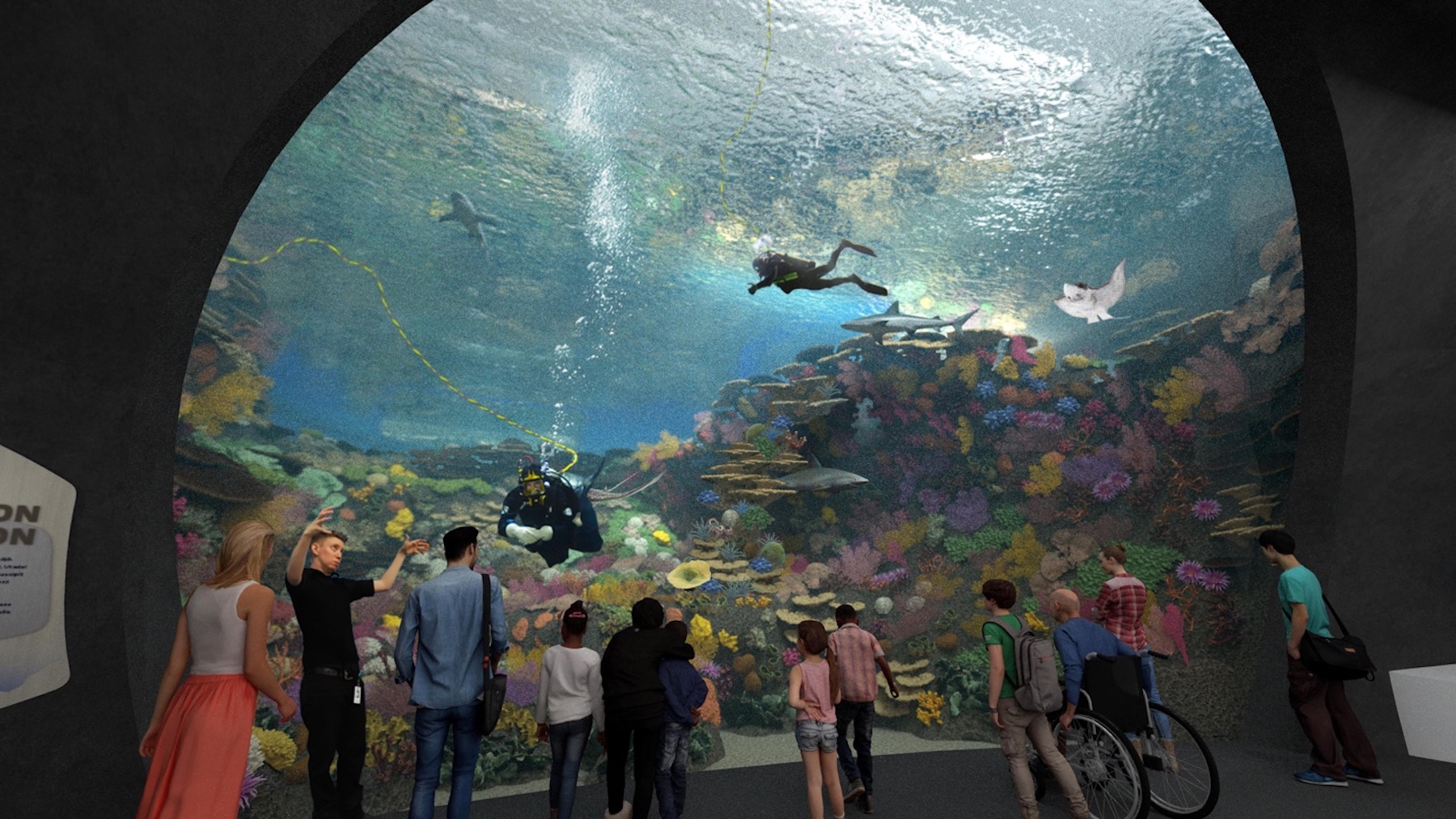

Related Stories
| Nov 25, 2013
Building Teams need to help owners avoid 'operational stray'
"Operational stray" occurs when a building’s MEP systems don’t work the way they should. Even the most well-designed and constructed building can stray from perfection—and that can cost the owner a ton in unnecessary utility costs. But help is on the way.
| Nov 19, 2013
Top 10 green building products for 2014
Assa Abloy's power-over-ethernet access-control locks and Schüco's retrofit façade system are among the products to make BuildingGreen Inc.'s annual Top-10 Green Building Products list.
| Nov 13, 2013
Installed capacity of geothermal heat pumps to grow by 150% by 2020, says study
The worldwide installed capacity of GHP systems will reach 127.4 gigawatts-thermal over the next seven years, growth of nearly 150%, according to a recent report from Navigant Research.
| Nov 13, 2013
First look: Renzo Piano's addition to Louis Kahn's Kimbell Art Museum [slideshow]
The $135 million, 101,130-sf colonnaded pavilion by the famed architect opens later this month.
| Oct 30, 2013
15 stellar historic preservation, adaptive reuse, and renovation projects
The winners of the 2013 Reconstruction Awards showcase the best work of distinguished Building Teams, encompassing historic preservation, adaptive reuse, and renovations and additions.
| Oct 30, 2013
Steven Holl selected for Culture and Art Center in Qingdao, besting Zaha Hadid, OMA
Steven Holl Architects has been selected by near unanimous jury decision as the winner of the new Culture and Art Center of Qingdao City competition, besting OMA and Zaha Hadid Architects. The 2 million-sf project for four museums is the heart of the new extension of Qingdao, China, planned for a population of 700,000.
| Oct 30, 2013
11 hot BIM/VDC topics for 2013
If you like to geek out on building information modeling and virtual design and construction, you should enjoy this overview of the top BIM/VDC topics.
| Oct 29, 2013
BIG opens subterranean Danish National Maritime Museum [slideshow]
BIG (Bjarke Ingels Group) has completed the Danish National Maritime Museum in Helsingør. By marrying the crucial historic elements with an innovative concept of galleries and way-finding, BIG’s renovation scheme reflects Denmark's historical and contemporary role as one of the world's leading maritime nations.
| Oct 28, 2013
Urban growth doesn’t have to destroy nature—it can work with it
Our collective desire to live in cities has never been stronger. According to the World Health Organization, 60% of the world’s population will live in a city by 2030. As urban populations swell, what people demand from their cities is evolving.
| Oct 18, 2013
Researchers discover tension-fusing properties of metal
When a group of MIT researchers recently discovered that stress can cause metal alloy to fuse rather than break apart, they assumed it must be a mistake. It wasn't. The surprising finding could lead to self-healing materials that repair early damage before it has a chance to spread.


